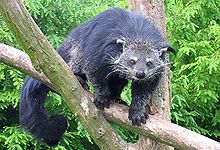
Arctictis binturong

The binturong (/bɪnˈtuːrɒŋ/ bin-TOO-rong) (Arctictis binturong), also known as bearcat, is a viverrid native to South and Southeast Asia. It is uncommon in much of its range, and has been assessed as Vulnerable on the IUCN Red List because of a declining population trend that is estimated at more than 30% over the last three decades. Although called 'bearcat', this omnivorous mammal is not closely related to either bears or cats but to the palm civets of Asia. It is a monotypic genus. Its genus name Arctictis means 'bear-weasel', from Greek arkt- 'bear' + iktis 'weasel'. In 1822, Thomas Stamford Raffles first described a specimen from Malacca. In Riau, Indonesia it was known as tenturun. The body of the binturong is long and heavy, with short, stout legs. It has a thick fur of strong black hair. The bushy and prehensile tail is thick at the root, gradually diminishing in size to the extremity, where it curls inwards. The muzzle is short and pointed, somewhat turned up at the nose, and is covered with bristly hairs, brown at the points, which lengthen as they diverge, and form a peculiar radiated circle round the face. The eyes are large, black and prominent. The ears are short, rounded, edged with white, and terminated by tufts of black hair. There are six short rounded incisors in each jaw, two canines, which are long and sharp, and six molars on each side. The hair on the legs is short and of a yellowish tinge. The feet are five-toed, with large strong claws; the soles are bare, and applied to the ground throughout the whole of their length; the hind ones are longer than the fore. In general build the binturong is essentially like Paradoxurus and Paguma but more massive in the length of the tail, legs and feet, in the structure of the scent glands and larger size of rhinarium, which is more convex with a median groove being much narrower above the philtrum. The contour hairs of the coat are much longer and coarser, and the long hairs clothing the whole of the back of the ears project beyond the tip as a definite tuft. The anterior bursa flap of the ears is more widely and less deeply emarginate. The tail is more muscular, especially at the base, and in colour generally like the body, but commonly paler at the base beneath. The body hairs are frequently partly whitish or buff, giving a speckled appearance to the pelage, sometimes so pale that the whole body is mostly straw-coloured or grey, the young being often at all events paler than the adults, but the head is always closely speckled with grey or buff. The long mystacial vibrissae are conspicuously white, and there is a white rim on the summit of the otherwise black ear. The glandular area is whitish. The tail is nearly as long as the head and body, which ranges from 28 to 33 in (71 to 84 cm); the tail is 26 to 27 in (66 to 69 cm) long. Some captive binturongs measured from 2 ft 6 in (76 cm) to 3 ft (91 cm) in head and body with a tail of 2 ft 4 in (71 cm). Mean weight of captive adult females is 21.9 kg (48 lb) with a range from 11 to 32 kg (24 to 71 lb). Captive animals often weigh more than wild counterparts. Both sexes have scent glands; in females on either side of the vulva, in males between the scrotum and penis. Their musk glands emit an odor reminiscent of popcorn or corn chips, likely due to the volatile compound 2-acetyl-1-pyrroline, found in their urine, which is also produced in the Maillard reaction at high temperatures. The binturong is the largest living species of the Viverridae, only rivaled by the African civet. Females are 20% larger than males.
